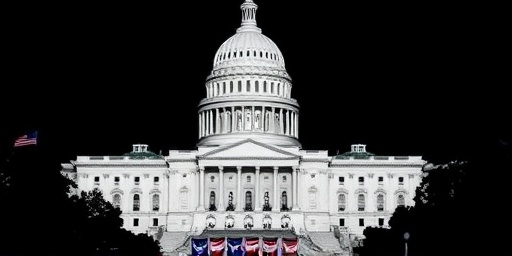In a dramatic move to rein in Washington’s ballooning deficits, incoming House Republican leadership has unveiled a sweeping blueprint to slash federal spending by $2 trillion over the next decade. The ambitious plan, released amid growing alarm over the nation’s $34 trillion debt, zeroes in on long-sacred entitlements like Social Security and Medicare, as well as green energy subsidies that have fueled billions in recent climate initiatives.
This Republican-led initiative promises to balance the federal budget for the first time in decades, but it immediately sparked fierce debate on Capitol Hill. With the GOP set to take control of the House in January, leaders like incoming Speaker Kevin McCarthy framed the proposal as a ‘fiscal lifeline’ for future generations, warning that unchecked spending could trigger economic catastrophe.
GOP Blueprint Targets Entitlements Amid Fiscal Urgency
The heart of the Republicans‘ budget cuts lies in overhauling entitlement programs, which currently consume more than half of the federal budget. According to the plan, detailed in a 50-page document circulated to GOP members, lawmakers propose trimming $1.2 trillion from Social Security and Medicare through measures like raising the retirement age to 69 for future beneficiaries and implementing means-testing to curb payments to higher-income seniors.
‘America’s debt is a ticking time bomb, and entitlements are the fuse,’ said Rep. Jodey Arrington (R-Texas), chair of the House Budget Committee, in an exclusive interview. ‘We’ve got to make tough choices now to protect the programs we all cherish, not let them implode under their own weight.’
Statistics underscore the urgency: The Congressional Budget Office (CBO) projects that federal debt held by the public will reach 114% of GDP by 2032 without intervention, up from 100% today. Entitlements drove much of the $6.8 trillion in federal spending last fiscal year, with Social Security alone accounting for $1.2 trillion. Republicans argue that modest reforms—such as adjusting cost-of-living increases based on chained CPI—could save hundreds of billions without gutting benefits for the truly needy.
Yet, the proposal isn’t without controversy. AARP, the influential seniors’ advocacy group, blasted the cuts as ‘reckless,’ estimating they could leave 10 million retirees facing reduced incomes. ‘This isn’t fiscal responsibility; it’s robbing Peter to pay Paul,’ AARP CEO Jo Ann Jenkins stated in a press release.
Green Energy Subsidies Face Axe in Republican Spending Overhaul
Beyond entitlements, the GOP plan takes direct aim at the Biden administration’s green energy agenda, proposing to eliminate $500 billion in subsidies for renewable projects over the next 10 years. This includes scrapping tax credits under the Inflation Reduction Act (IRA) that have poured $369 billion into solar, wind, and electric vehicle incentives since 2022.
Rep. Cathy McMorris Rodgers (R-Wash.), incoming chair of the Energy and Commerce Committee, defended the cuts by highlighting what she called ‘wasteful boondoggles.’ ‘We’re subsidizing unproven technologies with taxpayer dollars while families struggle with 20% energy inflation,’ she said during a virtual town hall. Data from the Treasury Department shows that green subsidies have already cost $80 billion in forgone revenue this year, with critics like the Republicans labeling them as corporate welfare for companies like Tesla and solar giants.
The blueprint also calls for rescinding unspent funds from the IRA, estimated at $200 billion, and halting new grants for climate research. Proponents point to a Heritage Foundation analysis claiming these cuts could reduce the deficit by 15% without derailing energy independence, as domestic oil and gas production hits record highs.
Environmental groups, however, decried the move as a ‘climate suicide pact.’ The Sierra Club’s executive director, Jon Devine, warned that axing subsidies would ‘hand the future to fossil fuels,’ potentially adding 1.5 billion tons of CO2 emissions by 2030, per their internal modeling. This clash highlights the partisan divide: Democrats view green investments as essential for combating global warming, while Republicans see them as ideological extravagance amid economic pressures.
National Debt Crisis Fuels Republican Push for Budget Discipline
The backdrop to this Republican spending crusade is America’s escalating debt burden, which now exceeds $34.5 trillion and grows by $2.5 trillion annually due to interest payments alone. The GOP blueprint explicitly ties its cuts to stabilizing this trajectory, projecting a balanced budget by 2033 if enacted in full.
Federal Reserve Chair Jerome Powell recently echoed these concerns, testifying before Congress that ‘high debt levels pose risks to long-term growth and financial stability.’ Interest on the debt already rivals defense spending at $660 billion yearly, siphoning funds from infrastructure and education. Republicans, fresh off midterm gains, are leveraging this narrative to rally their base, with polls from Rasmussen Reports showing 62% of voters favoring spending reductions to curb debt.
The plan’s broader scope includes $300 billion in cuts to discretionary spending, such as foreign aid and federal bureaucracy. For instance, it proposes consolidating 150 overlapping agencies to save $100 billion, drawing from recommendations by the Government Accountability Office (GAO). Historical context adds weight: The last balanced budget came in 2001 under President Clinton and a GOP Congress, but since then, deficits have averaged $1 trillion annually, exacerbated by wars, recessions, and pandemics.
Economists are divided. Nobel laureate Paul Krugman called the plan ‘austerity theater,’ arguing in a New York Times op-ed that cuts could stifle growth during a fragile recovery. Conversely, the Committee for a Responsible Federal Budget praised it as ‘a credible starting point,’ though noting implementation hurdles like Senate filibusters.
Democratic Opposition and Bipartisan Hurdles Emerge
As House Republicans celebrate their blueprint, Democrats are mounting a vigorous defense of key programs. Senate Majority Leader Chuck Schumer (D-N.Y.) labeled the cuts ‘extreme and out of touch,’ vowing to block them in the upper chamber. ‘This is a giveaway to the wealthy at the expense of working families,’ Schumer said, pointing to the plan’s avoidance of tax hikes on corporations.
The political landscape complicates passage: With a slim House majority of five seats and a 51-49 Democratic Senate, reconciliation rules may be the only path forward, limiting the bill to budget-related items. Quotes from moderate Republicans like Rep. Brian Fitzpatrick (R-Pa.) reveal internal tensions: ‘We need cuts, but not at the cost of our commitments to veterans and the elderly.’
Stakeholder reactions pour in. The U.S. Chamber of Commerce supports trimming regulations but warns against subsidy eliminations that could hurt manufacturing jobs—green energy initiatives have created 3 million positions since 2021, per the Bureau of Labor Statistics. Labor unions, including the AFL-CIO, rally against entitlement reforms, organizing protests in swing districts.
Broader implications touch every American: Cuts could lower inflation by curbing money supply, but they risk widening inequality if safety nets fray. A Moody’s Analytics forecast suggests successful implementation might boost GDP by 0.5% annually through restored investor confidence, yet failure could spike borrowing costs to 5% on 10-year Treasuries.
Path Forward: Implementation Challenges and Economic Ripple Effects
Looking ahead, the Republican budget cuts face a marathon to reality. Hearings begin in early January, with the full House vote targeted for March. Success hinges on unifying the GOP caucus and peeling off a few Senate Democrats, perhaps through compromises like protecting low-income Medicare benefits.
If passed, the plan could reshape fiscal policy for years, signaling a shift from expansive spending to restraint. Analysts at Goldman Sachs predict it might ease pressure on the dollar, stabilizing global markets wary of U.S. profligacy. Yet, veto threats from President Biden loom, forcing negotiations that could dilute the $2 trillion target.
For everyday citizens, the stakes are personal: Reduced debt means lower future taxes, but immediate cuts could strain retirees and green job seekers. As Rep. Arrington put it, ‘This is about legacy—will we hand our kids a solvent nation or a bankrupt one?’ The battle over spending and debt is just beginning, with ripple effects poised to define the 118th Congress.









